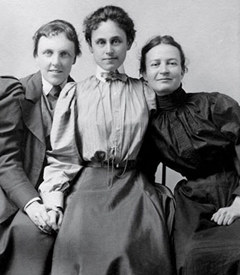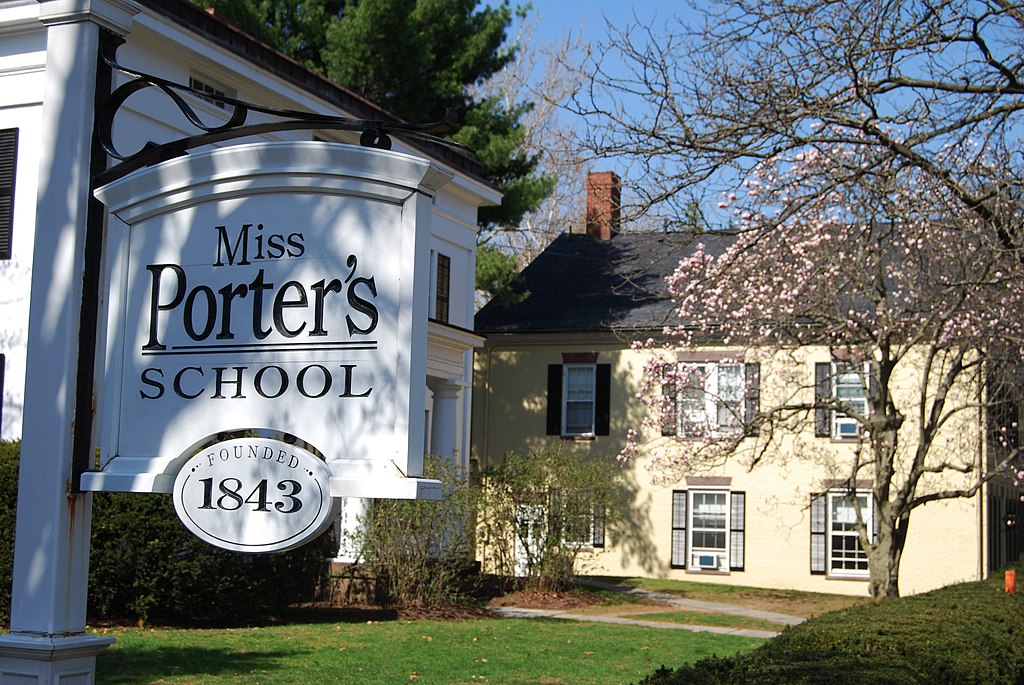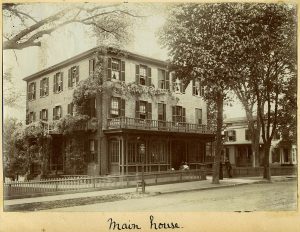By Edward T. Howe
Miss Porter’s School, founded in 1843 in Farmington, is an elite, female, privately funded, 40-acre, educational institution in central Connecticut. Its original mission was to train young girls to become useful Christian wives through development of their academic learning, moral values, social skills, and music and art appreciation. A hundred years later, the focus began shifting toward college preparation with an increasingly diversified student body.
Emergence of Female Academies and Seminaries
In the late 18th and early 19th centuries, female academies and seminaries emerged as wealthier families wanted more suitable education beyond public school offerings for their daughters. These institutions provided instruction in social skills, moral values, academic subjects, and “accomplishments”—appreciation of art, music, dancing, and needlework.
Among the earliest entities in Connecticut were the Morris Academy in Litchfield and Greenwich Academy—both coeducational. All-female academies included the Litchfield Female Academy founded by Sarah Pierce, the Hartford Female Seminary founded by Catherine Beecher, the Canterbury Female Boarding School founded by Prudence Crandall, and Miss Porter’s School in Farmington.
Establishment of Miss Porter’s School
The daughter of a Congregational minister, Sarah Porter received her education at the Farmington Academy and the New Haven Female Institute. After teaching in Springfield, Massachusetts, and in Philadelphia, she returned to Farmington and opened a school above the village store with 18 students in 1843. Unable to expand her school and knowing that boarding students with her family was a burden for her parents, Porter closed the school and took a teaching position in Buffalo, New York.
Once again, she returned home in 1847 to run a new two-story schoolhouse built by the Farmington Female Seminary Association as a counterpart to the now all-male Farmington Academy. Porter subsequently rented the Union Hotel in 1850, which became the main building—she finally bought the structure in 1866.
Most of the students who entered her school were around 15 years old and stayed anywhere from one to three years. They came mostly from New England Congregational and Presbyterian families. Over the course of the school’s tenure, it educated women such as Dr. Alice Hamilton, architect Theodate Pope Riddle, First Lady Jackie Kennedy Onassis, and many more.
Miss Porter’s Curriculum

Theodate Pope, Alice Hamilton, and a student believed to be Agnes Hamilton, 1888 – Wikimedia Commons
At the start, the school year had three terms of 14 weeks each running from October to July. Porter arranged a schedule of courses for each student that included languages (e.g., French and German), natural sciences, geography, history, English literature, logic, psychology, and mathematics. There were no grades. Music and drawing classes required additional payments, but the school amply provided instruction in social skills and manners.
Porter’s curriculum often reflected influences from Yale University—due to both Porter’s own education from Yale tutors and the fact that her brother, Noah Porter Jr., was president of Yale from 1871 to 1886. Upon completion of her studies, each student received a recommendation from Sarah Porter, without any accompanying diploma. By 1917, the school awarded diplomas for those who earned credits beyond those required for high school graduation.
Apart from classes, the school day involved morning and evening prayers, calisthenics, a one-hour walk, and evening readings by Porter. Students spent Saturdays looking after their rooms, clothes, and enjoying entertainment (e.g., dances, concerts, and visitors). Sundays mainly involved church services and Porter’s Bible class. The school also encouraged participation in exercises (e.g., skating and rowing) and sports (e.g., tennis and baseball). The various classes and activities fostered strong bonds among the students, Porter, and the other teachers.
Changes at Miss Porter’s in the 20th Century
Contemplating retirement in 1884, Porter hired Mary Elizabeth Dunning Dow, a former student and widow and groomed her as the next Head of School. Porter gradually handed over duties to Dow until Porter’s death in 1900.
In 1903, Dow left her position as Head of School over disputes with Robert P. Keep—the nephew and executor of Porter’s estate—regarding management and money issues. Dow moved to Briarcliff, New York, and opened a new school for young women—reportedly, with over a hundred Porter students and about 16 faculty members. Back in Farmington, the Keep family ran Miss Porter’s School from 1903 to 1943.
In 1943, its centennial year, significant changes occurred at the school. It incorporated as a non-profit educational institution, its first board of trustees was chosen, and Ward L. Johnson became the first non-Porter Head of School. He immediately emphasized college preparation (briefly available from 1910 to 1916)—a major departure from its reputation as a “finishing school.”
As with any institution that has existed for decades, Miss Porter’s faced new challenges and changing ideas over the years. The school accepted its first Black student, Glenda Newell, in 1968. In the 1970s, Miss Porter’s considered—like many other girls’ schools at the time—merging with a boy’s school as coeducation became more popular. Despite discussions with schools such as Deerfield Academy (Massachusetts), Miss Porter’s remained an independent girls’ school. Since then, the school has remained an elite boarding and day school for students in grades nine through twelve.
Edward T. Howe, Ph.D., is Professor of Economics, Emeritus, at Siena College near Albany, N.Y.










